In the realm of personal finances, securing affordable car insurance is a crucial aspect that can significantly impact your budget. Navigating the world of insurance policies can be daunting, but with the right strategies, you can unlock substantial savings without compromising coverage.
Join us as we delve into the secrets of obtaining the cheapest car insurance, empowering you to make informed decisions and save money.
From comparing quotes to utilizing innovative technologies, this comprehensive guide will equip you with the knowledge and tools to optimize your car insurance expenses. Discover the art of maximizing discounts, leveraging your credit score, and exploring usage-based insurance options. Whether you’re a seasoned driver or a novice behind the wheel, these tips will help you secure the best deal on your car insurance policy.
Introduction
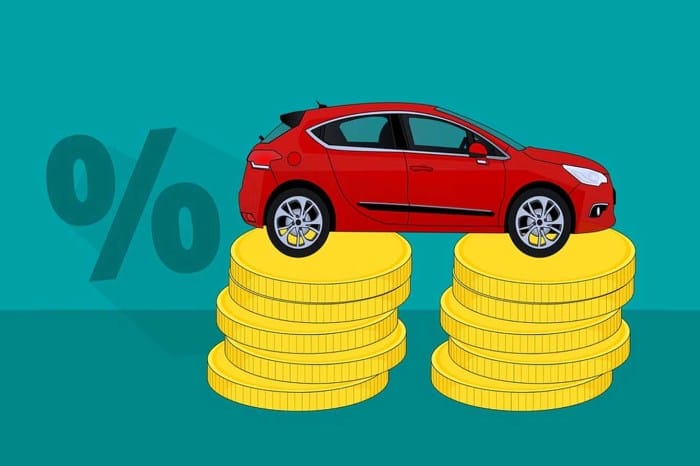
Obtaining affordable car insurance is crucial for responsible drivers, as it offers financial protection in the event of an accident and ensures compliance with legal requirements. Moreover, finding the cheapest car insurance can result in significant cost savings.According to a study by the National Association of Insurance Commissioners (NAIC), the average annual cost of car insurance in the United States is $1,500. However, there is a wide range of rates, with some drivers paying as little as $500 per year and others paying as much as $3,000 or more.
This variation in rates highlights the potential savings that can be achieved by finding the cheapest car insurance.
Factors Affecting Car Insurance Rates
Several factors influence car insurance rates, including the driver’s age, gender, driving history, type of vehicle, and location. Younger drivers, male drivers, and those with a history of accidents or traffic violations typically pay higher rates. Additionally, certain types of vehicles, such as sports cars and luxury vehicles, are more expensive to insure than others.
Strategies for Finding the Cheapest Car Insurance
There are several strategies that drivers can employ to find the cheapest car insurance. These include:
- Shopping around: Comparing quotes from multiple insurance companies is essential to finding the best deal. Drivers should obtain quotes from at least three different companies before making a decision.
- Bundling policies: Bundling car insurance with other types of insurance, such as homeowners or renters insurance, can often result in a discount.
- Increasing deductibles: A deductible is the amount that a driver is responsible for paying out of pocket before the insurance company begins to cover costs. Increasing the deductible can lower the premium.
- Taking advantage of discounts: Many insurance companies offer discounts for things like good driving records, taking defensive driving courses, or installing anti-theft devices.
Additional Tips for Saving Money on Car Insurance
In addition to the strategies mentioned above, there are a few other things that drivers can do to save money on car insurance, including:
- Maintaining a good driving record: Avoiding accidents and traffic violations can help keep insurance rates low.
- Choosing a safe vehicle: Vehicles with a high safety rating are typically less expensive to insure.
- Parking in a safe location: Parking in a garage or other secure location can reduce the risk of theft or vandalism, which can lower insurance rates.
Research and Comparison
Comparing car insurance quotes from multiple providers is crucial in finding the most affordable option. Different insurance companies have varying rates and terms, and comparing quotes ensures you get the best deal. Factors affecting premiums include age, driving history, vehicle type, and location.
Reliable Online Platforms
Numerous reliable online platforms and resources facilitate car insurance quote comparisons:
- Insurance Comparison Websites: Websites like Policygenius, The Zebra, and Compare.com allow users to compare quotes from multiple insurers simultaneously.
- Insurance Aggregators: Aggregators like CoverHound and Insurify collect quotes from various insurers and present them in a standardized format for easy comparison.
- Independent Insurance Agencies: These agencies represent multiple insurance companies and can provide quotes from several providers.
Discounts and Savings
Reducing the cost of car insurance is possible by taking advantage of various discounts and savings opportunities offered by insurance companies. These incentives aim to reward responsible driving behavior, loyalty, and bundling of policies. Understanding these discounts can help you maximize your savings on car insurance premiums.
Types of Discounts
Insurance companies offer a range of discounts to encourage safe driving habits and reward customer loyalty. Some common types of discounts include:
- Good Driver Discount: Rewarding drivers with a history of safe driving and no accidents or traffic violations.
- Multi-Car Discount: Providing a discount for insuring multiple vehicles under the same policy.
- Loyalty Discount: Rewarding customers who remain with the same insurance company for a specified period.
- Defensive Driving Course Discount: Offering a discount to drivers who complete an approved defensive driving course.
- Student Discount: Providing a discount to students with good academic成績 and maintaining a certain GPA.
- Occupation Discount: Offering a discount to individuals in certain professions considered to be lower risk.
Bundling Insurance Policies
Bundling multiple insurance policies with the same company can often lead to significant savings. This practice, known as bundling, is encouraged by insurance companies to promote customer retention and provide convenience to policyholders. By combining policies such as home and auto insurance, you can take advantage of lower premiums and simplified management of your insurance needs.
Comparing Rates with Discounts
The impact of discounts on car insurance rates can vary depending on the insurance company and individual circumstances. However, to illustrate the potential savings, consider the following table comparing average car insurance rates before and after applying common discounts:
| Discount | Average Rate Before Discount | Average Rate After Discount | Savings |
|---|---|---|---|
| Good Driver Discount | $1,200 | $1,000 | $200 |
| Multi-Car Discount | $2,000 | $1,800 | $200 |
| Loyalty Discount | $1,500 | $1,350 | $150 |
| Defensive Driving Course Discount | $1,300 | $1,100 | $200 |
| Student Discount | $1,400 | $1,200 | $200 |
| Occupation Discount | $1,600 | $1,400 | $200 |
These figures are approximate and may vary based on specific circumstances. However, they demonstrate the potential savings that can be achieved by taking advantage of available discounts.
4. Increase Credit Score
There’s a strong correlation between credit scores and car insurance rates. Those with higher credit scores often qualify for lower insurance premiums. This is because insurance companies see individuals with higher credit scores as being less risky to insure. They are more likely to pay their bills on time and file fewer claims.Improving
your credit score can save you money on car insurance. Here are a few strategies:
Pay Your Bills on Time
Payment history is a significant factor in determining your credit score. Paying your bills on time, every time, demonstrates your reliability and responsibility. Set up automatic payments to ensure you never miss a due date.
Reduce Your Debt
The amount of debt you have relative to your credit limits (credit utilization) also affects your credit score. Aim to keep your credit utilization below 30%. Pay down your balances as much as possible, especially on credit cards with high interest rates.
Get a Credit Builder Loan
If you have a limited credit history or a low credit score, consider getting a credit builder loan. These loans are designed to help you build credit by making regular payments over a period of time.
Dispute Errors on Your Credit Report
Review your credit report regularly for errors. If you find any, dispute them with the credit bureau. Correcting errors can improve your credit score.
Examples of How a Higher Credit Score Can Lead to Lower Insurance Premiums
* A driver with a credit score of 750 might pay $1,000 per year for car insurance, while a driver with a credit score of 650 might pay $1,200 per year for the same coverage.
A driver with a credit score of 800 might be eligible for a discount of 20% on their car insurance premium, while a driver with a credit score of 600 might not be eligible for any discounts.
Usage-Based Insurance
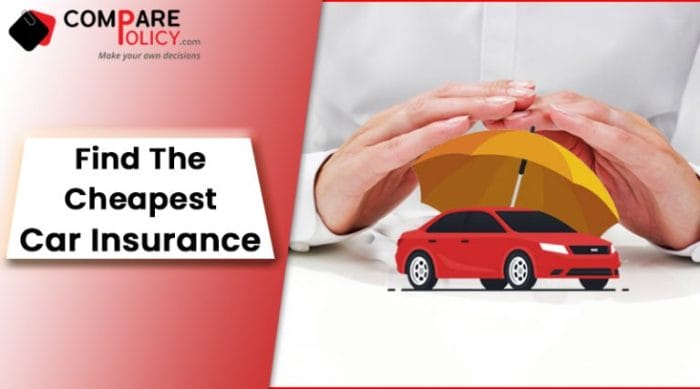
Usage-based insurance (UBI) is an innovative approach to car insurance that offers drivers the opportunity to save money by paying only for the miles they drive. Unlike traditional insurance policies that charge a flat rate based on various factors, UBI policies are designed to reward safe and responsible driving habits.UBI
programs use telematics devices installed in vehicles to collect data about driving behavior, such as mileage, braking patterns, acceleration, and time of day driven. This data is then used to calculate insurance premiums, with safer drivers paying lower rates.
Types of UBI Programs
There are two main types of UBI programs:
- Pay-as-you-drive (PAYD): PAYD policies charge drivers a base rate plus a per-mile fee. The more miles you drive, the higher your premium will be.
- Mileage-based insurance (MBI): MBI policies charge a flat rate per mile, regardless of how much you drive. This option is often more cost-effective for drivers who put fewer miles on their vehicles.
Benefits and Drawbacks of UBI
UBI offers several potential benefits to drivers, including:
- Cost savings: Drivers who participate in UBI programs can save money on their car insurance premiums by demonstrating safe driving habits.
- Fairer pricing: UBI policies are designed to charge drivers based on their actual driving behavior, rather than factors like age, gender, or credit score.
- Encouragement of safe driving: UBI programs can encourage drivers to adopt safer driving habits, which can lead to fewer accidents and a safer driving environment.
However, there are also some potential drawbacks to UBI, including:
- Privacy concerns: Some drivers may be concerned about the collection of data about their driving habits. UBI programs typically require the installation of a telematics device in the vehicle, which can track the driver’s location and other driving-related information.
- Limited availability: UBI programs are not yet widely available from all insurance companies. Drivers who are interested in UBI may need to shop around to find an insurance company that offers this type of policy.
Defensive Driving Courses
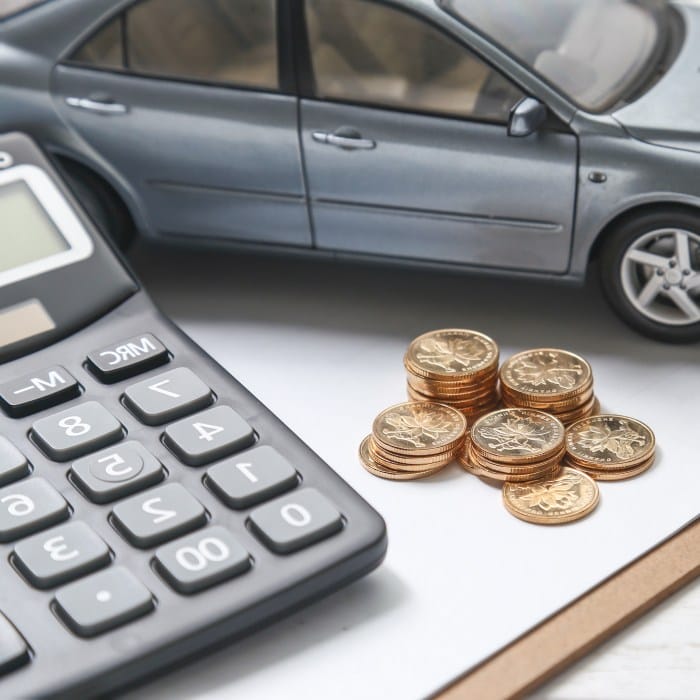
Taking defensive driving courses offers numerous benefits, including reduced insurance premiums and improved driving skills, leading to safer driving habits and potentially fewer accidents. These courses teach essential techniques for avoiding accidents, such as maintaining a safe following distance, recognizing and responding to hazardous situations, and understanding the importance of obeying traffic laws.
Organizations Offering Defensive Driving Courses
Several reputable organizations provide defensive driving courses. Some of the most well-known include:
- National Safety Council (NSC)
- American Automobile Association (AAA)
- American Safety Council (ASC)
- Drivers Education and Training Center (DETC)
Cost and Benefits of Defensive Driving Courses
The cost of a defensive driving course varies depending on the organization, location, and course format (online or in-person). Generally, the costs range from $25 to $100.The benefits of taking a defensive driving course can outweigh the costs. Insurance companies often offer discounts to drivers who have completed a defensive driving course, potentially saving hundreds of dollars on annual premiums.
Additionally, improved driving skills can reduce the likelihood of accidents, leading to further savings on insurance premiums and potential legal fees.
| Cost of Defensive Driving Course | Potential Savings on Insurance Premiums |
|---|---|
| $25-$100 | Up to $500 per year |
By taking a defensive driving course, drivers can potentially save money on insurance premiums, improve their driving skills, and reduce the risk of accidents.
Increase Deductible
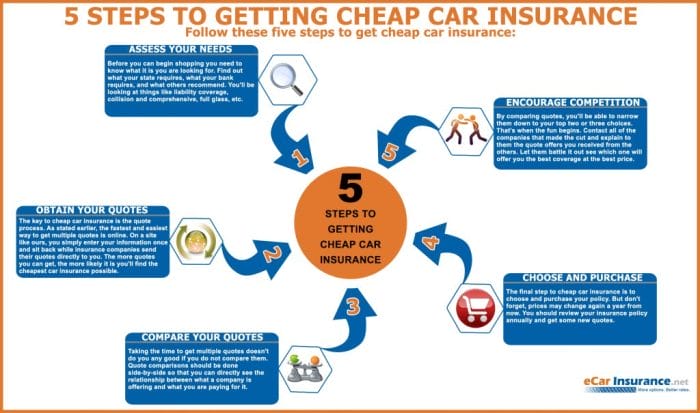
Raising your deductible is a simple and effective way to lower your car insurance premium. A deductible is the amount you pay out of pocket before your insurance coverage kicks in. The higher your deductible, the lower your premium will be.
However, it’s important to choose a deductible that you can afford to pay in case of an accident.
Determining the Right Deductible
The key to choosing the right deductible is to find a balance between affordability and risk. If you choose a deductible that is too high, you may end up paying more out of pocket in the event of an accident.
If you choose a deductible that is too low, you will pay a higher premium.A good rule of thumb is to choose a deductible that is equal to 1% of your car’s value. For example, if your car is worth $20,000, a $200 deductible would be a good starting point.
You can then adjust your deductible up or down based on your individual circumstances and risk tolerance.
Interactive Deductible Calculator
To help you determine the potential savings from increasing your deductible, we have created an interactive tool. Simply enter your current deductible, the amount you are considering increasing it to, and your annual premium. The tool will then calculate the estimated savings you could achieve.
8. Shop Around Periodically
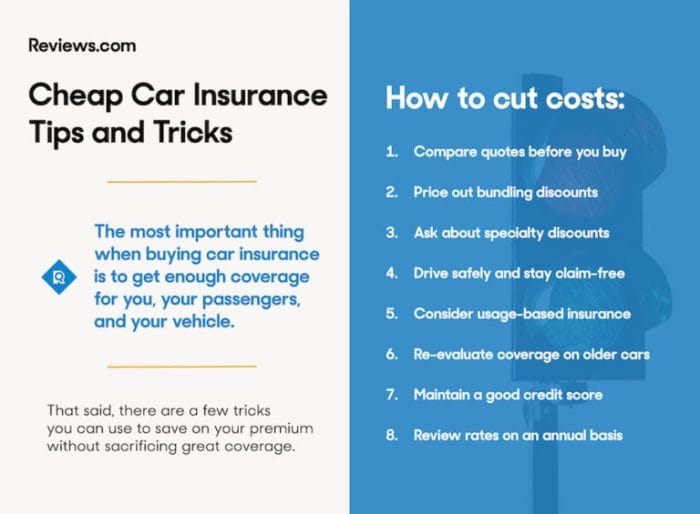
Regularly reviewing and comparing insurance policies can help you find better deals and save money on your car insurance. Aim to shop around for new insurance quotes every few years, or more frequently if you have experienced major life changes, such as a change in address, marital status, or driving record.
To shop for car insurance:
- Gather your information: Collect your current insurance policy information, including your policy number, coverage limits, and premium. You will also need your vehicle information, such as the make, model, and year.
- Get quotes online: Many insurance companies offer online quoting tools that allow you to compare rates from multiple companies quickly and easily. Be sure to compare quotes from at least three different companies.
- Talk to an insurance agent: If you prefer to speak with an insurance agent in person, you can visit a local insurance office or call an insurance company’s customer service line. An agent can help you compare quotes and explain the different coverage options available.
- Negotiate your premium: Once you have found a few insurance companies that offer competitive rates, you can negotiate your premium. Be prepared to provide information about your driving record, claims history, and any discounts you qualify for.
Consider Non-Owner Car Insurance
For individuals who do not own a vehicle but occasionally borrow or rent cars, non-owner car insurance offers a tailored solution to protect them while driving.
Non-owner car insurance provides coverage for drivers who do not have a personal vehicle but need insurance coverage when operating someone else’s car, such as a friend’s, family member’s, or rental vehicle. This type of insurance is designed to provide liability coverage, which protects the driver in case of an accident where they are at fault, and may also include additional coverage options such as collision, comprehensive, and uninsured/underinsured motorist coverage.
Comparison with Traditional Car Insurance
Compared to traditional car insurance policies, non-owner car insurance typically has lower premiums because it covers a limited range of scenarios. However, the coverage options may also be more limited, and the policy may not cover damage to the vehicle being driven.
| Feature | Non-Owner Car Insurance | Traditional Car Insurance |
|---|---|---|
| Coverage | Liability, optional additional coverage | Liability, collision, comprehensive, and other optional coverage |
| Premiums | Typically lower | Typically higher |
| Usage | For occasional drivers who borrow or rent cars | For vehicle owners who drive regularly |
10. Utilize Telematics Devices
Telematics devices are innovative tools that can help you track your driving behavior and potentially lower your car insurance premiums. These devices provide insurers with valuable data about your driving habits, such as speed, braking, and acceleration patterns, which can be used to assess your risk profile more accurately.
Types of Telematics Devices
There are various types of telematics devices available, each with its own features and capabilities. Some common types include:
- Plug-in Devices: These devices plug into your car’s diagnostic port and collect data about your driving behavior. They are relatively easy to install and can be used with most vehicles.
- Mobile Apps: Some insurance companies offer mobile apps that can track your driving behavior using your smartphone’s sensors. These apps are convenient and can be used with any vehicle.
- Installed Devices: These devices are permanently installed in your car by a professional. They provide the most comprehensive data about your driving behavior but are also more expensive and intrusive.
Costs and Benefits of Telematics Devices
The cost of a telematics device can vary depending on the type of device and the insurance company. However, the potential savings on your insurance premiums can often outweigh the cost of the device.
| Cost | Benefits |
|---|---|
| Plug-in Devices: $50-$100 | Potential Savings: 5%-15% |
| Mobile Apps: Free or low-cost | Potential Savings: 5%-10% |
| Installed Devices: $200-$500 | Potential Savings: 10%-20% |
Last Point
The journey to finding the cheapest car insurance is a continuous process that requires diligence and informed decision-making. By regularly reviewing your policy, exploring new options, and maintaining a良好的驾驶记录, you can consistently enjoy affordable coverage. Remember, the key to saving money on car insurance lies in being a proactive consumer, armed with knowledge and a commitment to finding the best deal.
Embrace these strategies, and you’ll be well on your way to securing the most cost-effective car insurance, allowing you to drive with peace of mind knowing you’re protected without breaking the bank.
FAQ Section
Can I get cheaper car insurance if I have a good credit score?
Yes, insurance companies often offer discounts to drivers with higher credit scores, recognizing their lower risk profile. Maintaining a good credit score can lead to significant savings on your car insurance premiums.
How does usage-based insurance (UBI) work?
UBI programs track your driving behavior through telematics devices installed in your vehicle. By monitoring factors like mileage, driving habits, and braking patterns, UBI can reward safe drivers with lower insurance premiums.
What are the benefits of taking a defensive driving course?
Defensive driving courses not only enhance your driving skills but can also lead to reduced insurance premiums. Insurance companies recognize the value of safe driving practices and often offer discounts to drivers who complete these courses.
What is a deductible, and how does it affect my insurance premiums?
A deductible is the amount you pay out of pocket before your insurance coverage kicks in. Choosing a higher deductible can lower your insurance premiums, but it’s essential to select an amount you can comfortably afford in case of an accident.
What is non-owner car insurance, and who needs it?
Non-owner car insurance is designed for individuals who do not own a vehicle but occasionally borrow or rent cars. It provides liability coverage in case of an accident while driving someone else’s car.



